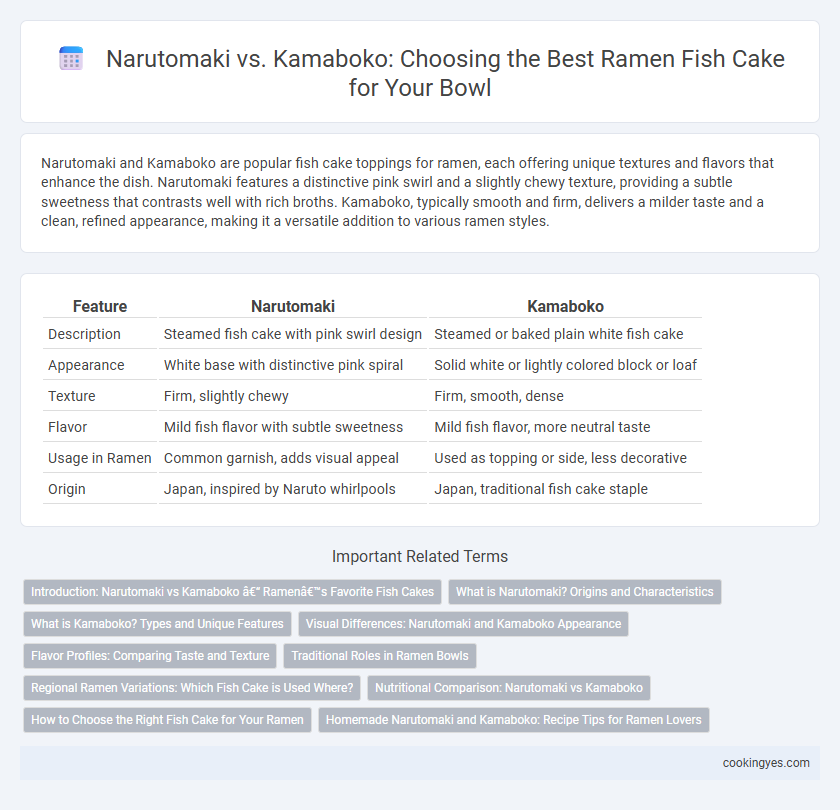Narutomaki and Kamaboko are popular fish cake toppings for ramen, each offering unique textures and flavors that enhance the dish. Narutomaki features a distinctive pink swirl and a slightly chewy texture, providing a subtle sweetness that contrasts well with rich broths. Kamaboko, typically smooth and firm, delivers a milder taste and a clean, refined appearance, making it a versatile addition to various ramen styles.
Table of Comparison
| Feature | Narutomaki | Kamaboko |
|---|---|---|
| Description | Steamed fish cake with pink swirl design | Steamed or baked plain white fish cake |
| Appearance | White base with distinctive pink spiral | Solid white or lightly colored block or loaf |
| Texture | Firm, slightly chewy | Firm, smooth, dense |
| Flavor | Mild fish flavor with subtle sweetness | Mild fish flavor, more neutral taste |
| Usage in Ramen | Common garnish, adds visual appeal | Used as topping or side, less decorative |
| Origin | Japan, inspired by Naruto whirlpools | Japan, traditional fish cake staple |
Introduction: Narutomaki vs Kamaboko – Ramen’s Favorite Fish Cakes
Narutomaki and Kamaboko are popular fish cake varieties used in ramen, each with distinct textures and flavors. Narutomaki features a signature pink swirl and a slightly chewy consistency, enhancing the visual appeal and adding a mild, savory taste to the broth. Kamaboko, typically smooth and firm, offers a subtler flavor that complements ramen without overpowering other ingredients.
What is Narutomaki? Origins and Characteristics
Narutomaki, a type of kamaboko, is a traditional Japanese fish cake distinguished by its iconic pink swirl pattern resembling the Naruto whirlpools in the Naruto Strait. Originating from Japan, this steamed fish paste is made from pureed white fish, giving it a firm, chewy texture and mild flavor that complements ramen broth. Its decorative design and subtle taste make narutomaki a popular topping in ramen dishes, adding both visual appeal and a delicate seafood essence.
What is Kamaboko? Types and Unique Features
Kamaboko is a traditional Japanese processed seafood product made from pureed white fish, known as surimi, that is steamed or baked until firm, often used as a ramen topping. There are several types of kamaboko, including white and pink varieties, with distinctive shapes such as the semicircular Momo-type and the cylindrical Maru-type, each offering a subtle sweetness and chewy texture. Unlike narutomaki, which features a signature pink swirl, kamaboko provides diverse visual appeal and milder flavors that complement the savory broth of ramen.
Visual Differences: Narutomaki and Kamaboko Appearance
Narutomaki features a distinctive pink swirl pattern resembling a whirlpool, making it visually striking atop ramen bowls, while kamaboko typically appears as smooth, solid-colored fish cake slices, often white with a pink outer layer. Narutomaki's spiral design adds a traditional aesthetic contrast against the broth, whereas kamaboko presents a simpler, more uniform look. Both enhance ramen presentation, but narutomaki is more recognizable for its iconic swirling appearance.
Flavor Profiles: Comparing Taste and Texture
Narutomaki features a mild, slightly sweet flavor with a firm, chewy texture and a distinctive pink swirl, adding visual appeal and subtle complexity to ramen. Kamaboko presents a denser, smoother texture with a more neutral, savory taste that absorbs broth flavors effectively without overpowering the dish. The choice between narutomaki and kamaboko influences the overall ramen experience by balancing taste intensity and mouthfeel, enhancing traditional Japanese noodle soups.
Traditional Roles in Ramen Bowls
Narutomaki features a distinctive pink swirl pattern and adds a mild fish flavor along with visual appeal to traditional ramen bowls. Kamaboko, often plain and white or pink, provides a denser texture and is used to enhance the broth's umami without overpowering other ingredients. Both fish cakes fulfill unique traditional roles, with narutomaki emphasizing aesthetics and kamaboko focusing on subtle taste and texture balance.
Regional Ramen Variations: Which Fish Cake is Used Where?
Narutomaki is commonly used in Tokyo-style ramen, characterized by its pink swirl pattern and firm texture, adding visual appeal and a mild fish flavor. Kamaboko, a plainer white or pink fish cake, often appears in Kansai and Kyushu ramen varieties, valued for its smooth texture and subtle taste. Regional ramen variations dictate fish cake choice based on local preferences and traditional recipes, with narutomaki favored in eastern Japan and kamaboko more prevalent in western regions.
Nutritional Comparison: Narutomaki vs Kamaboko
Narutomaki and kamaboko are both traditional Japanese fish cakes commonly used in ramen, but their nutritional profiles differ slightly. Narutomaki typically contains slightly more sodium and fewer proteins compared to kamaboko due to its spiral design incorporating more starch. Kamaboko offers a leaner protein content with lower calories, making it a preferable option for those seeking a healthier, high-protein ramen topping.
How to Choose the Right Fish Cake for Your Ramen
Narutomaki offers a distinctive swirl pattern and a slightly firmer texture, enhancing ramen with visual appeal and a mild, umami-rich flavor. Kamaboko provides a smoother, more delicate texture and a subtle sweetness, ideal for those seeking a softer fish cake that melds seamlessly with broth. Selecting the right fish cake depends on the desired texture contrast and flavor intensity to complement the overall ramen experience.
Homemade Narutomaki and Kamaboko: Recipe Tips for Ramen Lovers
Homemade narutomaki and kamaboko provide authentic flavor and texture for ramen enthusiasts seeking to enhance their bowls. Narutomaki, characterized by its iconic pink swirl, requires precise rolling of white fish paste with color added before steaming, while kamaboko involves simple shaping and steaming of pure white fish paste. Mastering the temperature and steaming time ensures firm, smooth fish cakes that complement the rich broth and tender noodles in ramen dishes.
Narutomaki vs Kamaboko for ramen fish cake Infographic

 cookingyes.com
cookingyes.com